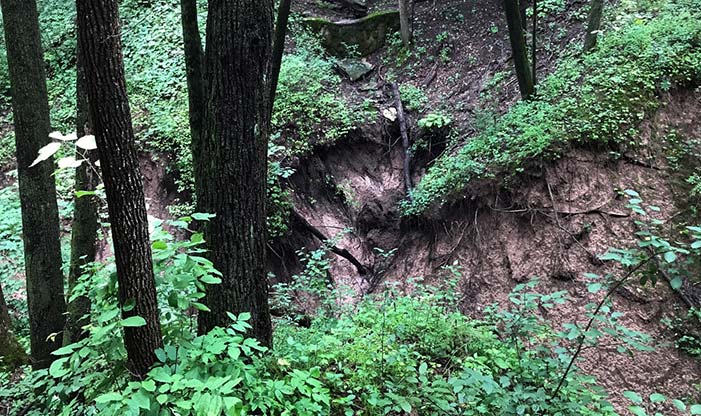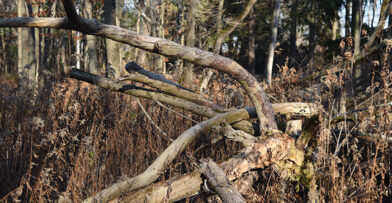One of the major goals of our 15-year Conservation Plan is in the process of being realized. We’re working with engineers and consultants on plans to stabilize Schlitz Audubon’s North Ravine as part of the Stormwater Wetland & Ravine Restoration Project. The primary goal of the effort is to stabilize the North Ravine lobe. This will help conserve biotic diversity in some of the highest quality forested habitat remaining in Milwaukee County. It will also slow erosion and keep sediments and pollution out of Lake Michigan. In order to accomplish this, it’s important to understand the roots of the ravine’s challenges.
Early and Late History of the Land
All of the land that is now known as the state of Wisconsin was surveyed between 1833 and 1866. During this time, William Austin Burt, who incidentally also invented the typewriter, led a three-man crew to survey a swath of forested coastline. This included what is now Schlitz Audubon. Once surveyed and mapped, the land was posted for sale by the federal government. Settlers began buying the newly-available parcels for family farms and small settlements. Within decades the virgin forest that had blanketed the area was nearly gone. The most recent Ice Age glaciers had left a ninety-foot layer of silty clay. Clearing the land had left it vulnerable. The clay is nearly devoid of stone, which makes this land susceptible to erosion.
Before being developed and farmed, the wetlands and forests in this area had functioned as a sponge for storing water. Though common practice at the time, the subsequent, systematic deforestation had unforeseen consequences on the health of the land.
Developing the Ravine
The arable land had been cleared for agriculture, while the ravine areas were saved. The installation of ditches, drains, roads, and structures on the developed land diminished the function of the natural systems that provide water-holding capacity. These changes caused nutrient- and sediment-filled stormwater to wash directly into Lake Michigan. This severely degraded the Center’s high-quality forested Lake Michigan habitat.
In the early 20th Century, erosion control began with the construction of concrete check dams, which were installed along the ravine floors to slow stormwater flow into Lake Michigan. Today, the majority of these check dams have failed. Instead, they are serving to exasperate the effects of water washing into the ravines. The ravine stabilization project includes removal of five failing concrete check dams. It also includes stabilizing deeply cut ravine lobes, armoring them with stone and sand.
Preventing Erosion and Preserving Species
Through the creation of berms and ponds in upland habitats, the Stormwater Wetland & Ravine Restoration Project will dramatically increase stormwater detention capacity. It will also prevent erosion of the ravine and its sediment from washing into Lake Michigan.
Today the North Ravine is home to endangered species like the Blue-stemmed Goldenrod, and Rusty Patched Bumble Bee, and 20 birds of greatest conservation need. This project will include intense restoration work throughout the project area. It will create a higher quality habitat for these important species and other native Wisconsin plants and animals that live within it.


